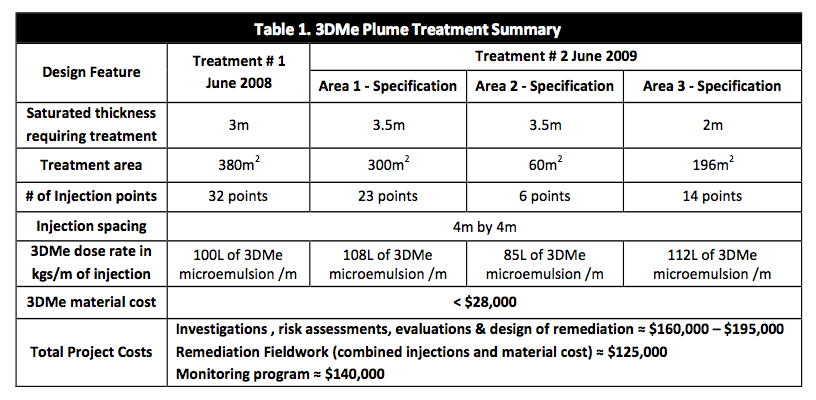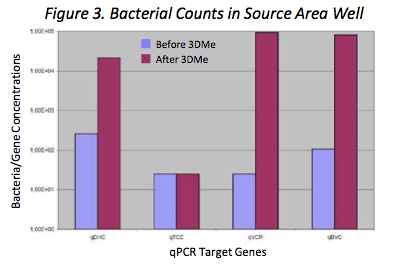Successful Treatment of Chlorinated Solvents using 3‐D Microemulsion (3DMe®) allows for Housing Redevelopment
BACKGROUND
Groundwater remediation was required at a former industrial site in order to allow for the completion of a large housing development project consisting of 330 apartments along the shore of a river (Figure 1). Membrane Interface Probe (MIP)1 data was used to delineate both the vertical and lateral extent of cis‐1,2‐ dichloroethene (DCE) and vinyl chloride (VC) contamination at the site. To enhance anaerobic bioremediation and bring the site to closure, 3‐D Microemulsion (3DMe®) was used to treat DCE and VC to the cleanup goals. Chlorinated solvent treatment was successful, achieving a 98 – 99% reduction in DCE and VC concentrations within 20 months (Figure 2). The site was granted closure and redevelopment was approved by the regulatory agency.

REMEDIATION HIGHLIGHTS
- Rate of dechlorination increased from 50% to nearly 100% as a result of the 3DMe injection
- Concentrations of DCE and VC reduced to below the cleanup goals
- Significant ethene production from the breakdown of DCE and VC
- Site closure achieved
- The success of the project was both supported and validated by the use of MIP data.

GROUNDWATER REMEDIAL STRATEGY
The remedial objective was to reduce concentrations of DCE and VC contamination in the groundwater to below the cleanup goal of 100μg/L. The maximum concentrations of DCE and VC were sampled at 19,000 μg/L and 12,000 μg/L, respectively. The 3DMe application was undertaken in two stages to allow for demolition works on‐site. Phase one (June 2008) included the injection of 3DMe into the eastern and western portions of the plume. Phase two (June 2009) included the injection of 3DMe in the previously inaccessible central plume area. Details of the injection are given in Table 1.

RESULTS
The degree of dechlorination was calculated to determine the progress of reductive dechlorination on‐site. Over the course of the treatment, a significant increase in full reductive dechlorination was observed as concentrations of DCE and VC were broken down to ethene. The degree of dechlorination increased from approximately 50% to nearly 100% within the treatment area.
Quantification of microbial populations pre‐ and post‐3DMe application, clearly demonstrated that the microbial populations had increased (Figure 3) and were supported by the controlled supply of hydrogen from 3DMe to the treatment area. This was complimented by a corresponding increase in the degradation rate after the treatment was undertaken.
Compound Specific Isotope Analysis (CSIA) was undertaken as a final line of evidence. Transformation of organic compounds by biological processes can cause significant shifts in the ratios of 13C to 12C (δ13C) in both the reactants and products of the reaction. This occurs as a result of slower degradation kinetics associated with the heavier isotope 13C in comparison to 12C. As a result, molecules with the lighter isotopes tend to be transformed more rapidly, resulting in isotopic fractionation between 13C in the residual reactant and 12C in the initial product. For example, isotopic fractionation was reported for both DCE (‐9.1 to +5.2‰) and VC (‐22.0 to +27‰) between May 2008 and February 2010. This is evidence that the reduction in chlorinated solvent concentrations was not the result of abiotic processes such as physical dilution and dispersion, as isotope fractionation typically only occurs due to biological degradation of the chlorinated solvents.

CONCLUSION
Within two months of the 3DMe application, the rate of reductive dechlorination increased substantially. This was evidenced by:
- Sequential production and degradation of daughter compounds
- Significant increase in ethene concentrations post‐3DMe injection
- An increase in biomass and activity of microorganisms performing reductive dechlorination
- Isotopic fractionation between the parent and daughter compounds resulting from degradation
- An overall reduction in chlorinated compound concentrations in the groundwater
Contaminant levels throughout the plume were reduced to below the cleanup goals within 20 months of the 3DMe application and regulatory acceptance for redevelopment of the site was secured.


 Americas
Americas Europe
Europe Français
Français Deutsch
Deutsch Italiano
Italiano Español
Español


